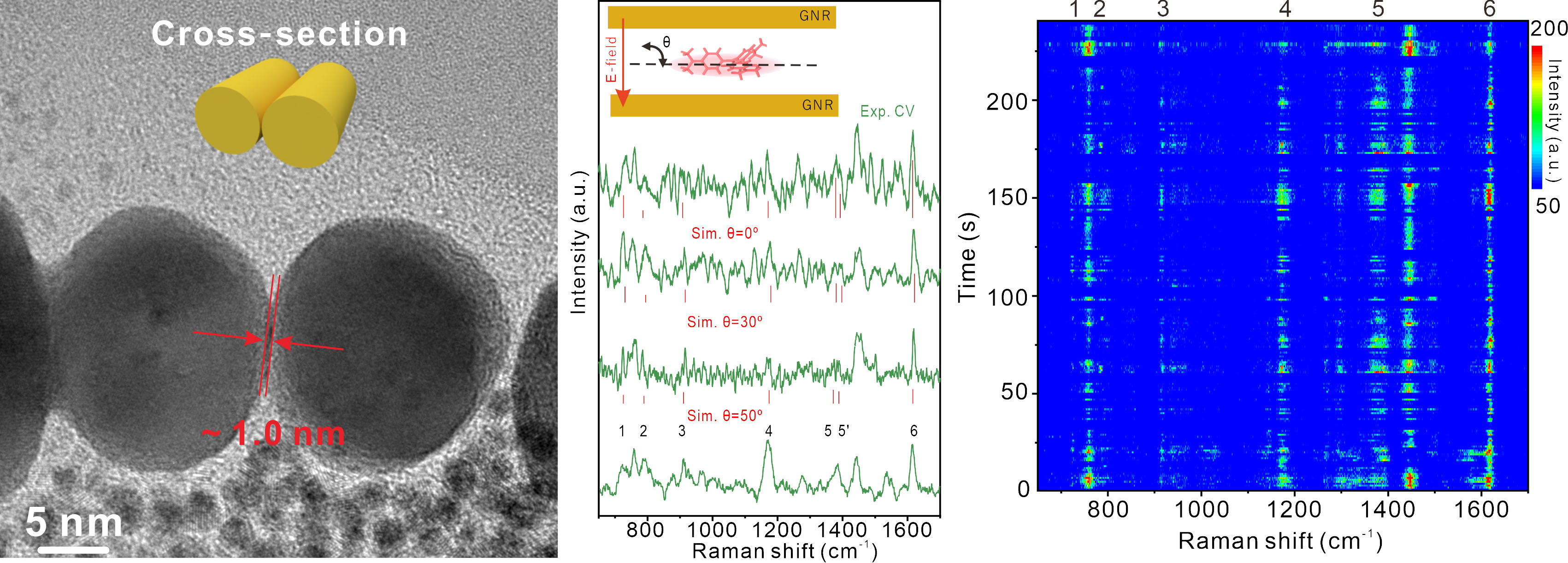| Oct 12, 2023 |
Using SERS technology to accurately monitor single-molecule diffusion behavior
(Nanowerk News) Researchers have developed a new technique to observe the behavior of individual molecules in real time.
|
Key Takeaways
|
|
A new method using gold nanorods can trap and observe individual molecules in real-time using dynamic surface-enhanced Raman spectroscopy (D-SERS).
Developed by the Hefei Institutes of Physical Science in China, this technique offers both sensitivity and stability for prolonged molecular observation.
The method demonstrated its effectiveness by trapping extremely dilute crystal violet dye molecules, observing them for up to 4 minutes continuously.
The technique allows researchers to understand the behavior of molecules in tight nano-spaces, offering valuable insights for fields like chemistry and biophysics.
This approach promises potential for observing atomic-scale processes without altering the molecule, providing a natural view into reactions and processes.
|
 |
| Left: Transmission electron micrograph of the cross-section of laser reconfigured gold nanorods; Middle: results of the detection and analysis of single-molecule diffusion behavior; Right: results of SERS-mapping of crystalline violet molecules in 4 min. (Image: YAN Wuwen)
|
The Research
|
|
The method, outlined in a paper published in the Journal of Physical Chemistry Letters ("ARTIKEL"), leverages the unique properties of gold nanorods to create tiny gaps that can "trap" single molecules. Monitoring the trapped molecules with an imaging technique called dynamic surface-enhanced Raman spectroscopy (D-SERS) allows researchers to follow the random orientations a molecule adopts in an extremely restricted space.
|
|
Though many techniques can detect single molecules, continuous monitoring remains challenging. The gold nanorod platform devised by chemists at the Hefei Institutes of Physical Science in China provides the sensitivity and stability needed for prolonged observation.
|
|
Gold nanorods are valuable tools in chemistry and biomedical research because of their strong light absorption and scattering properties. The Chinese researchers found that by alternating laser pulses of high and low intensity, they could prompt the nanorods to draw together into clusters with nanoscale gaps between them.
|
|
These tiny crevices essentially serve as cages that isolate individual guest molecules while enhancing spectroscopic signals. "We have constructed a highly enhanced hotspot space of ~1.0 nm for long-term sustainable single-molecule observation with D-SERS," said principal investigator Dr. Liangbao Yang.
|
|
To demonstrate the approach, the researchers trapped crystal violet dye molecules in the gaps. Though crystal violet concentrations were extremely dilute - just one molecule per laser spot - the spectroscopic signature remained strong enough to continuously monitor for up to 4 minutes.
|
|
The spectra showed the telltale blinking pattern that reveals single molecule detection. By acquiring rapid measurements, the researchers could discern the molecule flipping to different orientations in the confined space. Comparing experimental data to computer simulations, they determined the most stable poses keep the molecule relatively flat, between 50-90 degrees relative to the gold surface.
|
|
This orientation preference likely stems from the ultra-narrow gaps created by the technique. The results provide new insight on the behavior of molecules in restrictive nano-environments.
|
|
While previous methods can briefly hold a molecule in one position, the gold nanorod platform allows observation for vastly extended periods. The durable encapsulation protects fragile molecules from environmental disturbances.
|
|
Co-author Dr. Hyun-Hang Shin explained the significance: “These advantages can be leveraged to further investigate the fundamental mechanisms of SERS and the mechanisms of chemical reactions at the single-molecule level regardless of the chemical species of the reactant.”
|
|
The researchers suggest their technique could be adapted to incorporate ultrafast SERS capabilities that operate on the femtosecond scale. By upgrading to higher speed measurements, subtle molecular fluctuations may become perceptible.
|
|
The study demonstrates sensitive real-time monitoring of an isolated biomolecule without chemical modification or tethering. The passive trapping approach could provide a window into atomic-scale processes relevant to chemistry, biophysics, and materials science. Optical traps that constrain but don't actively manipulate single molecules will enable researchers to follow reactions as they naturally unfold.
|
|
|

